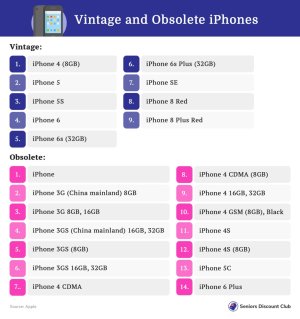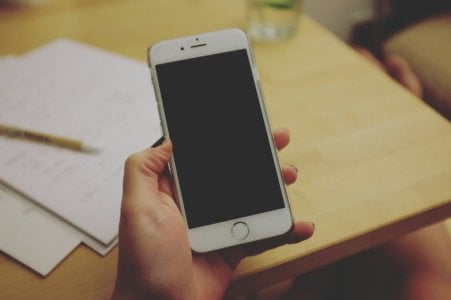Are your Apple gadgets about to become ‘obsolete’?
As technology advances rapidly in the digital age, many of our once-beloved devices are being left behind.
Recently, tech giant Apple updated its list of products that are considered 'obsolete’—and if you're still holding onto one of their older phone models, it might be time to consider an upgrade.
The iPhone 6 Plus, a device that once represented the pinnacle of mobile technology with its larger screen and improved camera, has now been officially classified as obsolete by Apple.
This classification is more than just a label; it has real implications for users of older technology.
Apple has a system for categorising its older products, dividing them into 'vintage' and 'obsolete’.
The distinction between the two is crucial for understanding the level of support you can expect for your device.
A 'vintage' product is one that hasn't been sold for more than five but less than seven years.
These devices still receive some support, albeit limited.
However, once a device crosses the seven-year threshold without being sold, it enters the 'obsolete' category.
When a product is declared obsolete, Apple discontinues all hardware services for it. This means that authorised service providers can no longer order parts for these products, making repairs increasingly difficult, if not impossible.
Additionally, obsolete products are often ineligible for the latest software updates, leaving them vulnerable to security risks and without the latest features and improvements.
As of now, nine iPhones have been designated as vintage and 14 are considered obsolete.

But not just iPhones are affected. The list of vintage and obsolete Apple products includes a range of devices, such as computers, iPads, iPods, Beats, and even Apple Watch models.
For those curious or concerned about whether their devices are on the list, Apple provides a comprehensive rundown on their website.
It's a valuable resource for planning future purchases and understanding when your current gadgets might start to show their age.
It's worth noting that while an obsolete device may still function, its limitations could become more pronounced over time.
For instance, as app developers focus on newer operating systems, you may find that some of your favourite apps no longer work on an older device.
Furthermore, as security updates become unavailable, your personal information could be at greater risk.
Staying ahead of these changes is essential for our community members who rely on their Apple devices for everything from video calls with grandchildren to managing health apps.
If your device is becoming outdated, it's wise to explore your options. Whether trading in your old device for a newer model or switching to a different brand offering longer support, there are plenty of ways to stay connected and secure in the digital world.

Have you had to upgrade recently, or are you holding onto a vintage device that is still going strong? Share your stories in the comments below!
Recently, tech giant Apple updated its list of products that are considered 'obsolete’—and if you're still holding onto one of their older phone models, it might be time to consider an upgrade.
The iPhone 6 Plus, a device that once represented the pinnacle of mobile technology with its larger screen and improved camera, has now been officially classified as obsolete by Apple.
This classification is more than just a label; it has real implications for users of older technology.
Apple has a system for categorising its older products, dividing them into 'vintage' and 'obsolete’.
The distinction between the two is crucial for understanding the level of support you can expect for your device.
A 'vintage' product is one that hasn't been sold for more than five but less than seven years.
These devices still receive some support, albeit limited.
However, once a device crosses the seven-year threshold without being sold, it enters the 'obsolete' category.
When a product is declared obsolete, Apple discontinues all hardware services for it. This means that authorised service providers can no longer order parts for these products, making repairs increasingly difficult, if not impossible.
Additionally, obsolete products are often ineligible for the latest software updates, leaving them vulnerable to security risks and without the latest features and improvements.
As of now, nine iPhones have been designated as vintage and 14 are considered obsolete.

But not just iPhones are affected. The list of vintage and obsolete Apple products includes a range of devices, such as computers, iPads, iPods, Beats, and even Apple Watch models.
For those curious or concerned about whether their devices are on the list, Apple provides a comprehensive rundown on their website.
It's a valuable resource for planning future purchases and understanding when your current gadgets might start to show their age.
It's worth noting that while an obsolete device may still function, its limitations could become more pronounced over time.
For instance, as app developers focus on newer operating systems, you may find that some of your favourite apps no longer work on an older device.
Furthermore, as security updates become unavailable, your personal information could be at greater risk.
Staying ahead of these changes is essential for our community members who rely on their Apple devices for everything from video calls with grandchildren to managing health apps.
If your device is becoming outdated, it's wise to explore your options. Whether trading in your old device for a newer model or switching to a different brand offering longer support, there are plenty of ways to stay connected and secure in the digital world.
Key Takeaways
- Apple has officially classified The iPhone 6 Plus as 'obsolete'.
- Apple usually classifies a product as 'obsolete' more than seven years after it has not been sold.
- Obsolete status means Apple has discontinued all hardware services for the product, and service providers cannot order parts.
- The list of vintage and obsolete products, including iPhones, computers, iPads, iPods, Beats, and Apple Watch items, is available on the Apple website.
Last edited:








